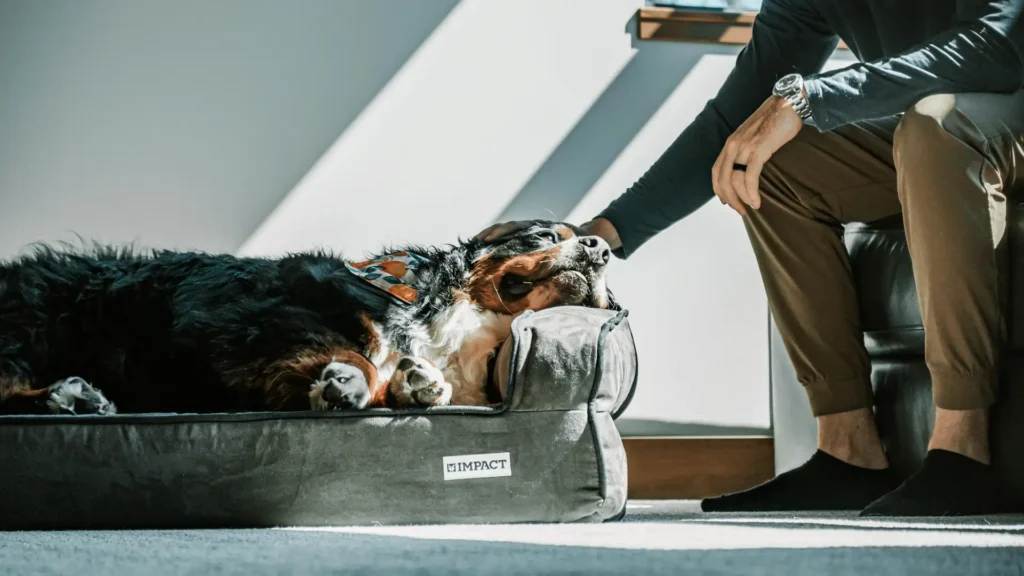Your dog is a cherished member of family. You always want the best for them—including where they sleep. Providing your furry friend with a comfortable place to rest is essential for their overall well-being. Here’s why investing in a good dog bed is one of the best decisions you can make for your canine companion.
Supports Joint Health
Dogs need proper support while sleeping to maintain joint health. This is important for dogs suffer from arthritis, hip dysplasia, and other musculoskeletal issues. Dogs require extra cushioning to relieve pressure on sensitive areas.
A well-designed dog bed provides support to reduce stiffness. It helps your dog wake up feeling refreshed rather than sore. Some beds feature memory foam and gel-infused foam that molds to your dog’s body shape. This type of bed distributes weight evenly and minimizes strain on joints. For dogs with mobility issues, these beds can be life-changing. These beds offer relief from chronic pain and promote better movement during waking hours.
Even active dogs benefit from supportive bedding. After a long day of running, their muscles and joints need time to recover. A quality dog bed ensures that recovery happens efficiently and comfortably. This reduces the risk of future injuries.
Promotes Better Sleep
Sleep is vital for dogs. On average, adult dogs sleep between 12 and 14 hours per day. Puppies and senior dogs sleep even longer.
During this time, their bodies repair tissues, regulate hormones, and recharge energy levels. Without adequate rest, dogs become irritable, and lethargic.
Quality sleep depends heavily on comfort. A hard floor or thin blanket simply won’t cut it for most dogs.
A good dog bed offers the right combination of softness and firmness to encourage uninterrupted sleep. The materials used in premium dog beds help regulate temperature. Memory foam, down alternatives, and breathable fabrics keep your pup cool in summer and warm in winter. This ensures that your dog gets the restorative rest they need to stay active and healthy.
For anxious dogs, a cozy bed serves as a calming sanctuary. Having a comfortable space to retreat can significantly reduce their anxiety levels.
Protects Against Injuries
Hard floors can pose risks to your dog’s physical health. Over time, lying on hard surfaces leads to calluses and sores. A supportive bed acts as a buffer. This shields your dog from potential harm and ensure their comfort throughout the day.
Dogs recovering from surgery need a soft surface to aid healing. Specialized recovery beds prevent complications by reducing pressure on surgical sites. For example, dogs undergoing spaying, neutering, and orthopedic surgeries will heal faster if they have a dedicated, supportive bed to rest on.
Additionally, certain breeds are susceptible to skin irritation due to their body structure. Deep-chested breeds like Greyhounds and Whippets, for instance, may develop bony protrusions that rub against hard surfaces. A high-quality dog bed prevents these issues. It allows your dog to relax.
Encourages Proper Resting Habits
Dogs instinctively seek out cozy spots to relax. Having their own designated bed reinforces positive behavior. By providing a dedicated space for sleep, you help establish boundaries and routines. This ownership helps your dog during training sessions. You can train your dog easily.
Moreover, a familiar bed gives your dog a sense of security. Bringing along their bed, when travelling, ease anxiety and provide a comforting reminder of home in unfamiliar environments. Knowing they have a safe place to rest reduce stress and promote relaxation.
Training your dog to use their bed consistently also has practical benefits. This ease crate training. This makes transitions smoother and less stressful for both you and your pet.
Improves Hygiene and Reduces Allergens
Letting your dog sleep directly on carpets, can trap dirt, hair, and allergens. It makes cleaning a constant challenge.
A washable dog bed simplifies maintenance. It keeps your living space cleaner. Many modern dog beds come with machine-washable covers. This handiness allows you to easily remove odors, stains, and allergens.
Furthermore, elevated dog beds prevent moisture buildup. An elevated bed keep your dog dry after rolling around in the grass. These beds are useful for dogs with allergies. They minimize exposure to dust mites and mold.
In multi-pet households, individual beds for each dog reduce conflicts and territorial disputes. When every dog has their own space, it fosters harmony and reduces competition for sleeping spots.
Tailored Comfort for Every Breed
Not all dogs want the same type of bedding. Small breeds might prefer snug spaces like cave-style beds. They mimic dens and provide a sense of security. Larger breeds, on the other hand, need spacious beds. Larger beds can accommodate their size and weight.
Active working dogs might benefit from cooling mats to regulate body temperature, while short-haired breeds may appreciate heated beds during colder months.
Choosing a bed tailored to your dog’s specific needs ensures maximum comfort. Consider factors like your dog’s age, size, activity level when selecting bed.
For puppies, look for durable, chew-resistant beds that can withstand teething. Orthopedic beds with memory foam are beneficial for senior dogs. Larger breeds need oversized beds with reinforced stitching to handle heavier weights.
Customizing your dog’s bed to their unique requirements shows that you care about their individual needs and enhances their quality of life.
Providing your dog with a quality bed demonstrates love and care. It strengthens the bond between you and your pet. When your dog feels safe in their environment, they’re happier, and better behaved. Plus, knowing that you’ve invested in their well-being can bring peace of mind to you as a responsible pet owner.
A dog bed isn’t just a piece of furniture. It’s a symbol of care and attention you give to your four-legged friend. Watching your dog curl up happily in their cozy bed is a rewarding experience that reminds you of the joy they bring into your life.
Factors to Consider When Choosing a Dog Bed
Selecting the perfect dog bed involves evaluating several key factors based on your dog’s individual characteristics and lifestyle. Here’s a detailed breakdown of what to consider.

Size and Weight
Size and weight of your dog play a critical role in determining the appropriate bed dimensions. Larger breeds require spacious beds that allow them to stretch out comfortably. Conversely, smaller breeds need compact beds.
For large and giant breeds, look for beds explicitly labeled jumbo or extra-large. Additionally, heavier dogs benefit from beds with reinforced frames and high-density foam. Smaller dogs, on the other hand, thrive in snug spaces that make them feel secure.
Sleeping Style
Dogs have distinct sleeping styles. Understanding these preferences can guide your choice of bed design.
Some dogs are sprawlers. Greyhounds, Dalmatians, and Boxers tend to stretch out completely when they sleep. Open beds without raised edges are ideal for these dogs. They offer maximum space and freedom of movement.
Some dogs are curlers. French Bulldogs, Shih Tzus, and Beagles prefer curling up into a ball. Donut-shaped beds with raised edges provide the perfect combination of coziness and head/neck support.
Some dogs are leaners. Golden Retrievers and German Shepherds enjoy leaning against something. Bolstered beds with side panels and armrests cater to this preference. They offer additional comfort and stability.
Understanding your dog’s sleeping habits ensures you select a bed that aligns with their natural tendencies. This enhances their sleep quality and satisfaction.
Health Concerns
Certain breeds face specific health challenges that should influence your decision.
Large and giant breeds are prone to joint problems. Orthopedic beds with memory foam relieve pressure points and promote proper spinal alignment. Memory foam conforms to your dog’s body shape. It distributes weight evenly and reduces strain on joints.
Dogs with allergies may react negatively to certain materials. Hypoallergenic beds made from natural fibers can help minimize irritation and improve comfort. If your dog is recovering from surgery, a supportive bed with extra padding can aid in healing by keeping pressure off injured areas and encouraging restful sleep.
Material and Durability
The material of the bed impacts its durability, and ease of maintenance.
Border Collies, Labradors, and Pit Bulls chew at their beds. Look for tough, chew-resistant materials like ballistic nylon, canvas, or Kevlar-reinforced fabric. Some brands specialize in indestructible beds designed specifically for aggressive chewers.
Beds with waterproof liners and removable covers protect the internal structure and simplify cleanup. Breathable materials like mesh or cooling gel-infused fabrics help regulate body temperature and prevent overheating.
Temperature Regulation
Different breeds have varying tolerance levels for temperature extremes. Thick-coated breeds like Huskies, Bernese Mountain Dogs, and Samoyeds benefit from cooling mats. These mats allow air to circulate underneath. These designs prevent overheating during hot weather.
Short-haired breeds like Greyhounds, Whippets, and Italian Greyhounds insulated beds during colder months. These beds retain warmth and shield dogs from drafts.
A good dog bed is much more than a luxury. It’s a necessity for promoting your dog’s health. The benefits of a high-quality bed extend far beyond convenience. Take the time to choose a bed that meets their unique needs.




